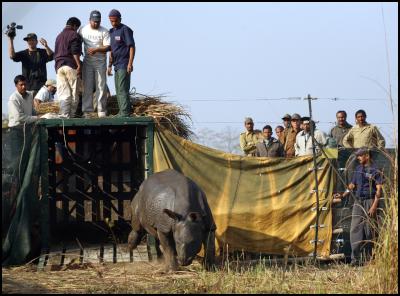IFAW Releases Rhinos Back To Wild in India
IFAW Releases Rhinos Back To Wild in India

Click to enlarge
IFAW Releases Rhinos Back To Wild in India
(Assam, India – 30 January 2007) – IFAW (the International Fund for Animal Welfare, www.ifaw.org) and its partner, WTI (Wildlife Trust of India), today announced the successful release of two one-horned Asian rhinos (Rhinoceros unicornis) back to the wild in India with support from Assam Forest Department.
The rhinos, female calves nicknamed Manasi and Roje, were rescued from the floodwaters that annually spill over the banks of the Brahmaputra River. The pair, both three years old, were rescued in the summer of 2004 and rehabilitated at the Centre for Rehabilitation and Conservation (CWRC). CWRC is located near Kaziranga National Park, in North East India, and was founded in 2001 through a collaboration between WTI, IFAW and the Assam Forest Department. CWRC was one of India's first multi-species rehabilitation centres and is designed to care for a variety of animals until they are capable of surviving release back into the wild.
“The rhinos will wear radio collars for post release monitoring,” said Dr. Ian Robinson, who heads up IFAW’s Emergency Relief team. “We want to do everything possible to assure a successful transition back to the wild for these animals.”
The rhinos were translocated from CWRC, via an overnight convoy, to Manas National Park and released at an event attended by more than 100 onlookers, wildlife experts, and dignitaries including Abhajit Rabha, Director of Manas National Park and Ritesh Bhattacharjee, Field Director of the Manas Tiger Project.
“We are confident that the rhinos will do well in Manas as we are involving not just governments but also the local people,” said M.C. Malakar, Chief Wildlife Warden of Assam. “The CWRC rescue centre has helped us rescue and rear more animals than before. I thank IFAW for setting up the rescue centre with WTI.”
“Manas once supported a lot of rhinos, however certain problems wiped them out. Now, as these rhino calves are released, it is good to release them in Manas as it is conductive to rhino populations,” said D.M. Singh, Director Kaziranga National Park. “Earlier we would rescue animals and take them to the zoo and that was the end. But now the CWRC rescue centre has made rehabilitation into the wild a possibility.”
At Manas the two rhinos will be held in an enclosure and will later join a four year old rhino that was moved there last year. IFAW and WTI released that female rhino at the same location in February 2006. It was the first rhino in Manas in more than a decade. Wild rhinos in Manas National Park, a World Heritage site, once numbered more than 100.
“The enormous effort of veterinary doctors, IFAW, the staff of the forest department, and the WTI animal keepers at the CWRC rescue centre has made this possible,” said Professor P.C. Bhattacharjee of WTI.
About IFAW (International Fund
for Animal Welfare)
Founded in 1969, IFAW works around
the globe to protect animals and habitats promoting
practical solutions for animals and people. To learn how you
can help, please visit
www.ifaw.org
ENDS


 Amnesty International Aotearoa NZ: Global - Recorded Executions Highest Since 2015
Amnesty International Aotearoa NZ: Global - Recorded Executions Highest Since 2015 Save The Children: MYANMAR - Heavy Rains Heighten Risk Of Disease Outbreaks Following Earthquake
Save The Children: MYANMAR - Heavy Rains Heighten Risk Of Disease Outbreaks Following Earthquake UNICEF Aotearoa NZ: Aid Cuts Threaten Fragile Progress In Ending Maternal Deaths, UN Agencies Warn
UNICEF Aotearoa NZ: Aid Cuts Threaten Fragile Progress In Ending Maternal Deaths, UN Agencies Warn Médecins Sans Frontières: Concern Over Planned Deportation Of Afghan Refugees In Pakistan
Médecins Sans Frontières: Concern Over Planned Deportation Of Afghan Refugees In Pakistan European Cultural Centre: Time Space Existence 2025 - A Collective Call To Repair, Regenerate, And Reuse
European Cultural Centre: Time Space Existence 2025 - A Collective Call To Repair, Regenerate, And Reuse John P. Ruehl, IMI: What Will Tech Moguls Do With Their Wealth?
John P. Ruehl, IMI: What Will Tech Moguls Do With Their Wealth?